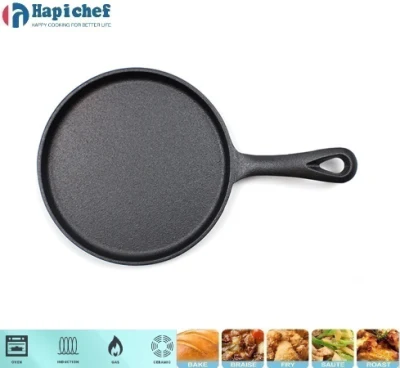What can I use cast iron cookware for?-pre seasoned cast iron cookware
What can I use cast iron cookware for?
Cast iron casserole dishes are real multi-taskers. Thanks to the way the metal evenly distributes and retains heat, you can use them to sear meats, sauté vegetables, slow cook, prepare roast dinners and even bake sourdough.
In fact, the possibilities are endless; they can be used on the hob and in the oven – just take note of the maximum temperature recommended by the manufacturer.
What should I look for in a cast iron casserole dish?
Materials
This is the biggest question to answer when shopping for a cast iron dish: do you want an uncoated dish or one that’s been finished with enamel?
Uncoated cast iron is the more traditional of the two, meaning you cook directly on the metal surface. It requires seasoning (where you rub a layer of oil on to the pan) to build up a protective and ever-improving natural, non-stick coating. This makes cleaning easier too as you shouldn’t need to scrub. Note that you shouldn’t soak uncoated cast iron, as this can increase the risk of rust.
If you opt for this finish, check how often the brand recommends you season. Some find seasoning a pan adds to the flavour of their food, and if you cook a lot with tomatoes, be aware that their acidity can cut through the coating, meaning you’ll have to season your dish more often.
Most of the options we’ve featured are enamelled. This removes the need for any seasoning and will help with washing up – you can rinse the dish without worrying about removing the coating, and some may even be suitable for the dishwasher. It still distributes heat evenly, too.
The non-stick capability of the enamel finishes we tested varied, meaning you may need to adjust the amount of oil you use. This finish is also more fragile than uncoated dishes, so be careful not to knock it or drop it. You may not be able to use metal utensils, either. Whichever you opt for, note that cast iron is very heavy.
Induction hob compatibility
If you’ve got this type of hob at home, check whether your desired dish is compatible. All the ones on our list are, but some took longer to heat up than others. However, given this style of pot does tend to heat up slowly anyway, we don’t think this is a deal-breaker.
Also, if you have a glass topped hob, note that cast iron dishes are very heavy, so be careful when using to avoid creating any scratches. For example, avoid dragging them across the surface and lift them off instead.
3PCS Pre-Seasoned Cast Iron Cookware Cast Iron Skillet Frying Pan
Size
Cast iron casserole dishes come in a range of sizes, from one-person minis that would look adorable at a dinner party, to those big enough to cook a Sunday roast in. It’s worth considering how many people you usually cook for, and potentially sizing up a little if you’re after versatility.
Shape
We’ve tested circular pots of similar proportions for consistency, but you can often find oval equivalents, which are handy for cooking joints of meat or roasting chickens.
Lid
All the pots on our list have self-basting lids which redistribute condensation to help lock moisture into your cooking.
Handles
Our winner comes with silicone covers for the handles to help with lifting, and shapes do vary. Make sure the handle design is one you think you can use with an oven glove.
Care
Whichever finish you choose, using your dish properly is essential to prolong its lifespan. Check which utensils you can use with your dish – metal ones are often off limits due to the risk of scratching. Look at how to clean it too. Most won’t be suitable for the dishwasher, and with uncoated cast iron, you’ll need to avoid soaking it and factor in regular seasoning – a step you can skip with enamel.
Also, be sure to follow accompanying care instructions; for example, some enamel dishes need to be heated slowly to avoid shocking the coating and creating cracks.
Warranty
This isn’t something you’d always consider for pots and pans, but when you’re potentially spending hundreds of pounds, it’s worth checking.
How we test casserole dishes
To find the best casserole dishes, our experts start by measuring how quickly and evenly each pot heats up across gas, electric and induction hobs. They then test it in an oven, checking it doesn’t sustain any damage when heated to its maximum recommended temperature.
Next come the cooking tests; testers sauté vegetables and sear beef before slow-cooking a beef stew. Then they roast a chicken, adding orzo to measure moisture retention. Finally, they bake a loaf of corn bread.
For each dish, they assess how thoroughly it cooks the food, whether it locks in moisture well, if it reaches their desired colour and of course, what the final product tastes like.
Finally, our experts check how easy each dish is to clean, looking at the amount of food residue left on the surface and analysing non-stick claims.
Throughout testing, they judge its overall ease of use and design. They also consider accompanying instructions and care guidance.
Because cast iron dishes are a life-long purchase, we’re continuing our testing of each pan at home and will update this article with our findings after a few months of use.
-
Revolutionary Cast Iron Griddles Redefine Outdoor CookingNewsMay.09,2025
-
The Ultimate Guide to Cast Iron BBQ GrillsNewsMay.09,2025
-
Revolutionize Your Kitchen with Premium Cast Iron Casserole CookwareNewsMay.09,2025
-
Premium Cast Iron Bakeware CollectionNewsMay.09,2025
-
Our Premium Cast Iron Skillets CollectionNewsMay.09,2025
-
Discover the Art of Cooking with Premium Cast Iron Dutch OvensNewsMay.09,2025
-
The Versatility of a Cast Iron CasseroleNewsApr.21,2025

